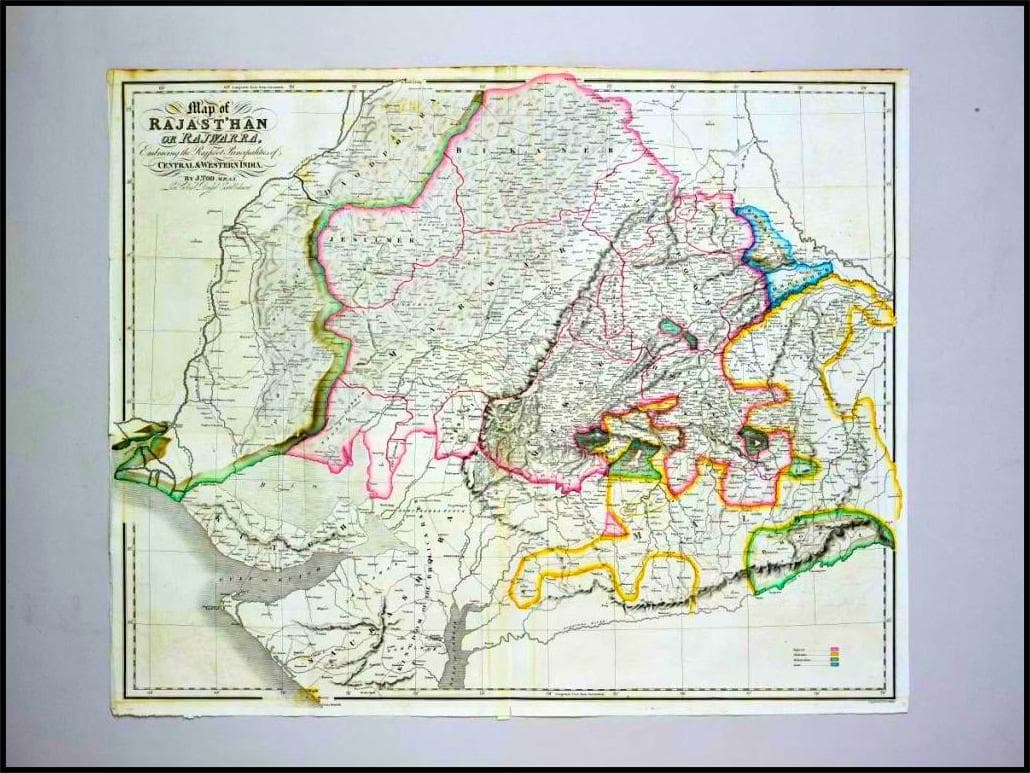Introduction to Rājasthān & Rājasthānī
Rājasthān

A region in the western half of the Republic of India, embodies within itself the codes of chivalry, freedom, and struggle, all these ideals that have merged out of the peculiar socio-political and geographical circumstances. Rājasthān or erstwhile Rājputānā merged with the Union of India in various phases, with the Union of India between 1947-48, and on 30 March 1949, it was reorganised as a state within the Union. The name Rajasthan, disputably, has been believed to be a byproduct of colonial modernity. Certain scholars have also looked at the Mughal administrative rationalities in delineating the region, as Ajmer Subā. There were various terms used for different parts of the region— Jāngal (Northern), Matsya (North-Eastern), Medapāt, Prāgvāt, Vāgad (South),Maru, Mād in the West, Gurjarātra (Southern and Western), Sapādalakṣa (Central Rajasthan). Various precolonial sources such as Muhantā Nainsī rī khyāt, Rājrupak of Virbhāņ Ratnu, Bankidās ri khyāt, Poķaraņ rī khyāt, etc., have used the term rajthān as a geographical marker roughly defining regions having Rajput political authority in Western India. The term Rājasthān in the twentieth century also remained a political geography entwined with the ideals of monarchy, tradition and thus, months before the partition of India, when the Mountbatten Plan had been announced, the Marāthā ruler of Indore, Nawāb of Bhopāl, and the Nizam of Hyderabad expressed their intention of merging with Rajasthan. The oral historians and sociologists have looked at the role of uniform customs, dressing patterns, cuisines, social structure, ecology, and political trajectories in the perception of Rājasthān, as a distinct socio-cultural unit. Therefore, Rājasthān as a cultural region might not be congruent with the current political delineations. It arguably might encompass the regions of Mālwā- Nimār (Western Madhya Pradesh), parts of tracts of Sirsā and Fatehbād in Haryana, the Thārparkar division of Sindh Province, and tracts of Banaskānthā and Sābarkānthā districts of Gujarat.
Rājasthānī

The language of the völk of Rājasthān, though has a rich literary tradition, under the pretext of Hindi nationalism prevalent in the Union of India, that dwells on inflating Hindi's prestige at a numerical as well as ideological level, since 1971, has been subordinate as a 'dialect' of Hindi. The various historical archives of Rājasthān in Jodhpur, Bīkaner, Udaipur, and Jaipur consist of lakhs of manuscripts testifying to the literary richness of Rājasthānī and its various dialects. Various literary genres emerged over a period of time— vāt, khyāt, vigat, rāso, nisāņī, jhulņo, velī, kundaliyā, vachanikā, rāso— demonstrating the imperatives of aesthetics and socio- political exigencies. The script of the language could be called Maru Gurjārī due to its ancestral links with Jain Nāgrī and Gurjarī Ghasitā. The ancestral language of modern Rājasthānī and Gujrātī was Maru Gurjarī Apabhramśa (MGAp.), also called Old Rājasthāni (Tessitori) or Old Gujarāti. There are various theories concerning the origin of Maru Gurjarī Apabhramśa, including those fromMahārāśtrī and Śauraśenī Prakrit, but recent scholarship of Imre Bangha and Sheldon Pollock cautions against the use of such overarching categories and suggests that MGAp. developed from the various prevalent Prakrits and other deśbhāśā such as Avanti, Sauraśtrī, Maru, and Gurjarī. The language received patronage and developed an extensive literary culture in the courts of Imperial Chālukyās of Pātan, Chahamāṇas of Ajmer, Nādol, Jālore and Guhiļ- Sisodiyās of Chittor. In the early fifteenth century, the divergence occurred with Rājasthānī developing a distinct literary tradition, as testified by Visaldevrāso of Nālha and Raņmalċanda of Sridhar Vyās. The descendants of Maru Gurjarī Apabhramśa include languages such as Gujarātī, Sauraśtri, Mārvādī, Bhīlī, Banjarī and Gojrī. Mārvādī formed the literary base for Modern Rājasthāni and played a fundamental role in the development of various eastern and Northern Rājasthānī speeches in the sixteenth century such as Dhundhārī, Bāgrī and others. These speeches owe their origin to the interaction between Northern Hindustānī speeches (Bangārū), Braj, Mārwādī, and Punjābī. Simultaneously, various Rājasthānī speeches developed their own literary styles, but they remained firmly located in cosmopolitan Mārwādī lexicography and themes.
Rajasthan's literary culture developed extensively in the Western and Southern regions of the state, thereby forming the core region of literary production. The themes of literature remained varied, from mythology, religion, political commentary, war, history, genealogy, and ethics, to name a few. The names of prominent scholars who laid the foundation of Rajasthan literary tradition through various genres are as follows: Aćalo Bāņiyo(Rānā Khetsī rā duhā) , Pasāyat Gādan (Rāv Ranmaļ ro rūpak), Harsūr Rohdiyo, Sridhar Vyās (Raņmalchanda), Padmanābh (Kānhade Prabandh), Bahādar Muhammad (Vīrmāyaņ), Vīțhū Sűjo (Rāv Jaitsī rō chand), Sāndū Mālā (Jhūlaņā Rāisinhjī rā, Jhūlaņā Dīwān Śrī Pratāpsinhji rā), Shivdās Gādaņ (Acaldās Khīćī rī vārtā), Vițhū Mehā (Pābujī rā ćanda), Asājī (Gogājī rī pedhī), Dūdo Āsiyo (Kālļā Rāymaļot ro kundaļiyo), Bārhaț Īsardās (Hālā Jhālā rā kundaļiyā), Dursā Ādhā (Marsiyā Rāv Surtāņ rā), Muhņot Naiņsī (Muhņot Naiņsī rī khyāt, Mārwār rā parganã rī vigat), Girdhar Āsiyã (Sagatrāso), Kiśordās Rāv (Rāj Prakaś), Khidiyā Jaggā (Vacanikā Rațhod Ratansinh Maheśdāsot rī), Khidiyā Bakhtā (Amdāvad rā jhagdā rā kavit), Sāndū Prithvirāj (Abhēvilās), and Kavirājā Bankīdās Āsiyā (Thaļvat Battīsī, Rūpsinh Rāypur rī jhamāļ).
Rājasthānī lies at a critical juncture in the twenty-first century, wherein the policy of systematic subjugation of the language and the political and cultural imposition of Hindī intends to destroy its rich linguistic treasure. John D. Smith, a literary historian, in his monograph on Pābujī, rightfully states that the claim of ancient Rājasthānī being a dialect of 'colt' Hindī would indeed be legitimate if Italians laid claim to French as its dialect. This website has been built with the perspective of ushering in an era of renaissance in the Rājasthānī society that must answer the call of themotherland (māyad bhōm) and mother tongue (māyad bhāsā) to become an active stakeholder in furthering their cause.
Bhavyanshsinh Mewār
(Research Scholar in Medieval History)
(Jawaharlal Nehru University, New Delhi)